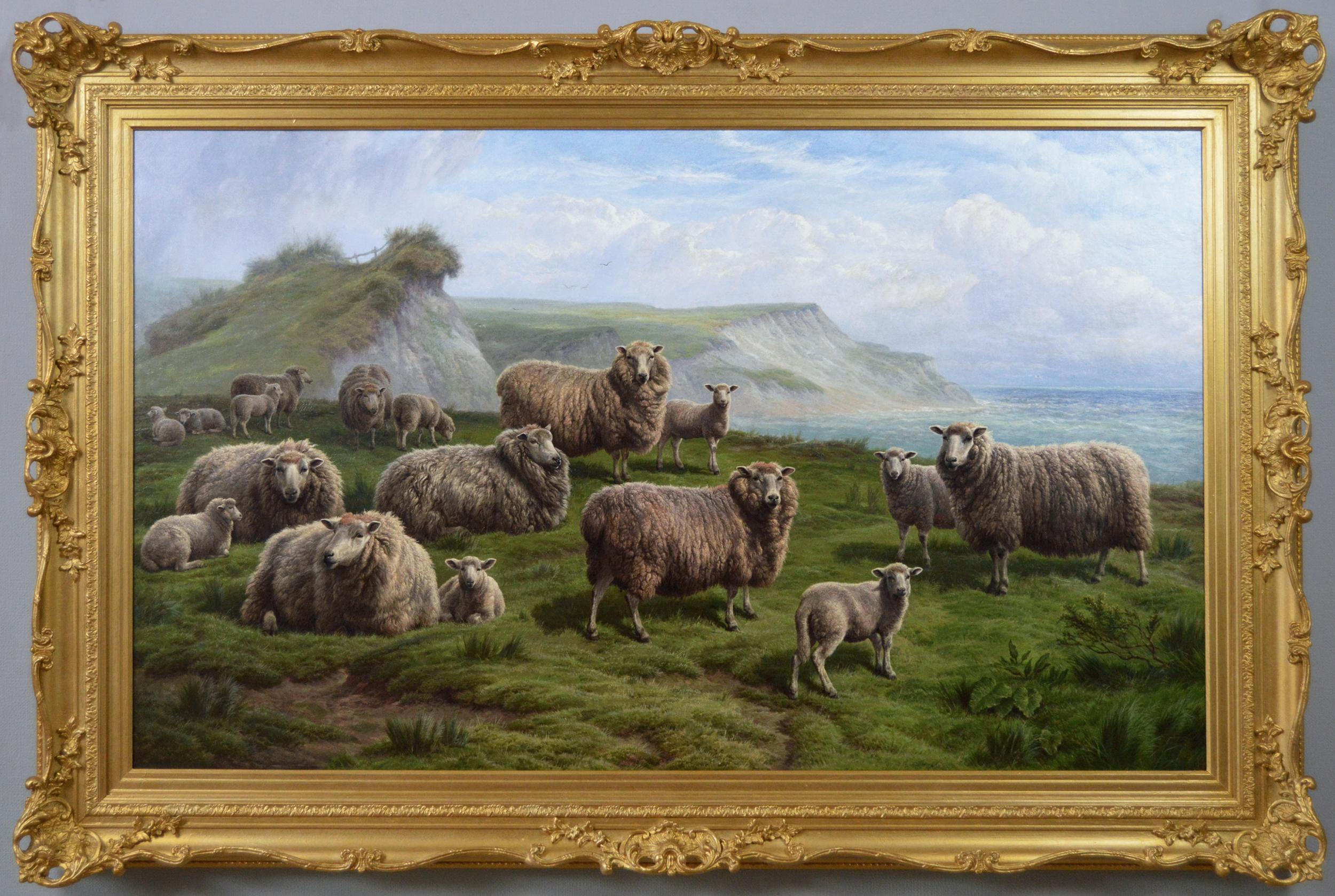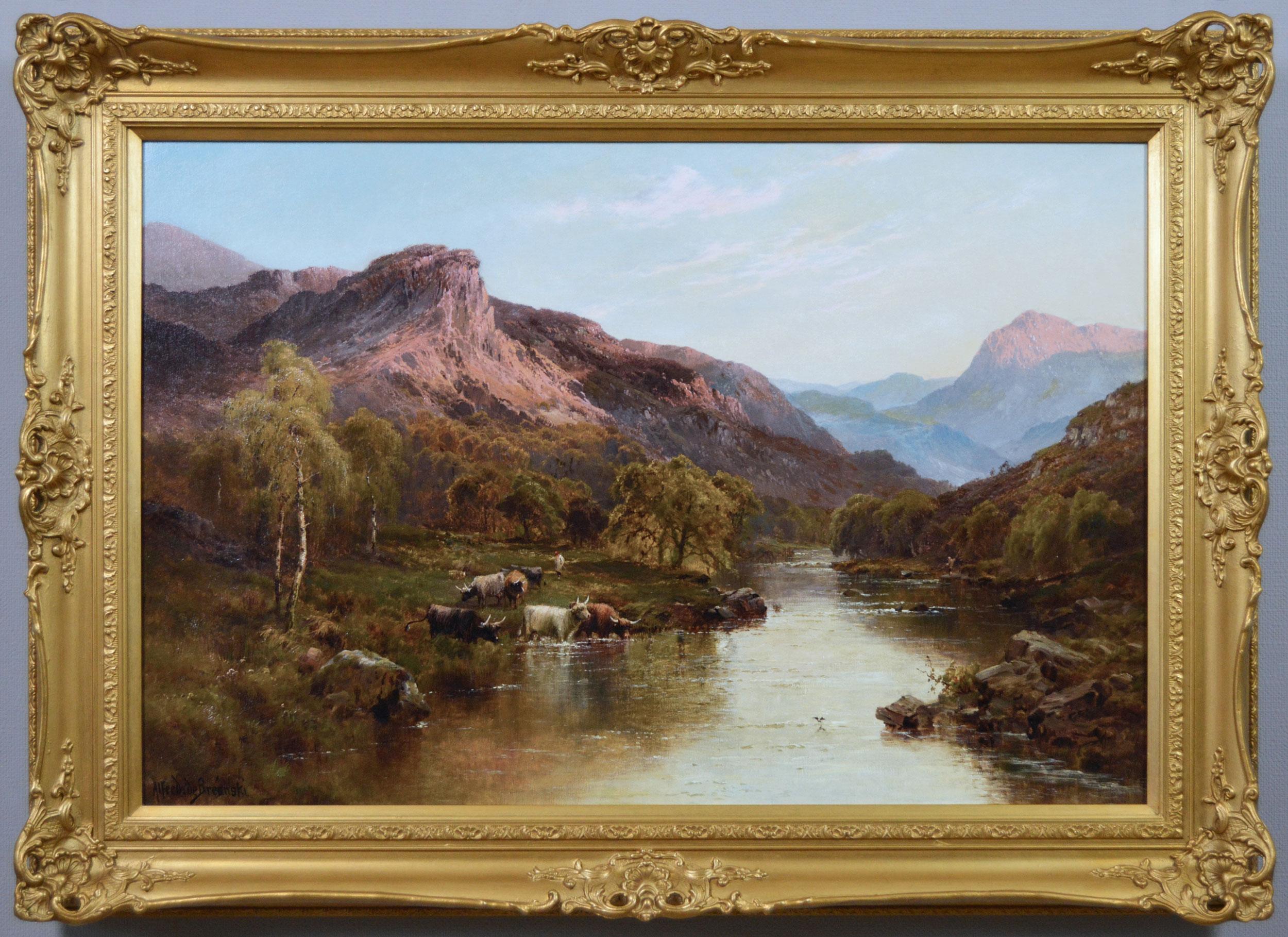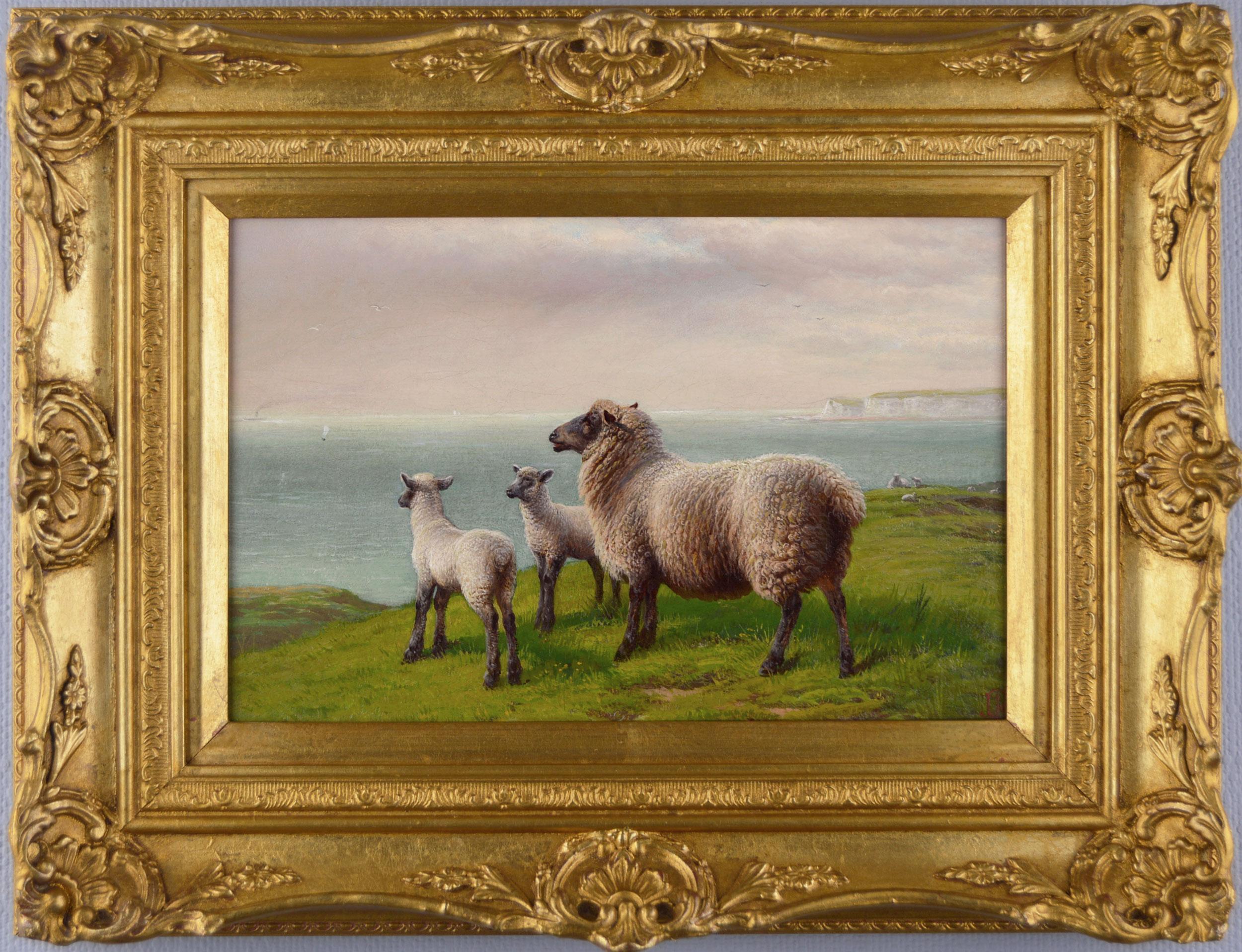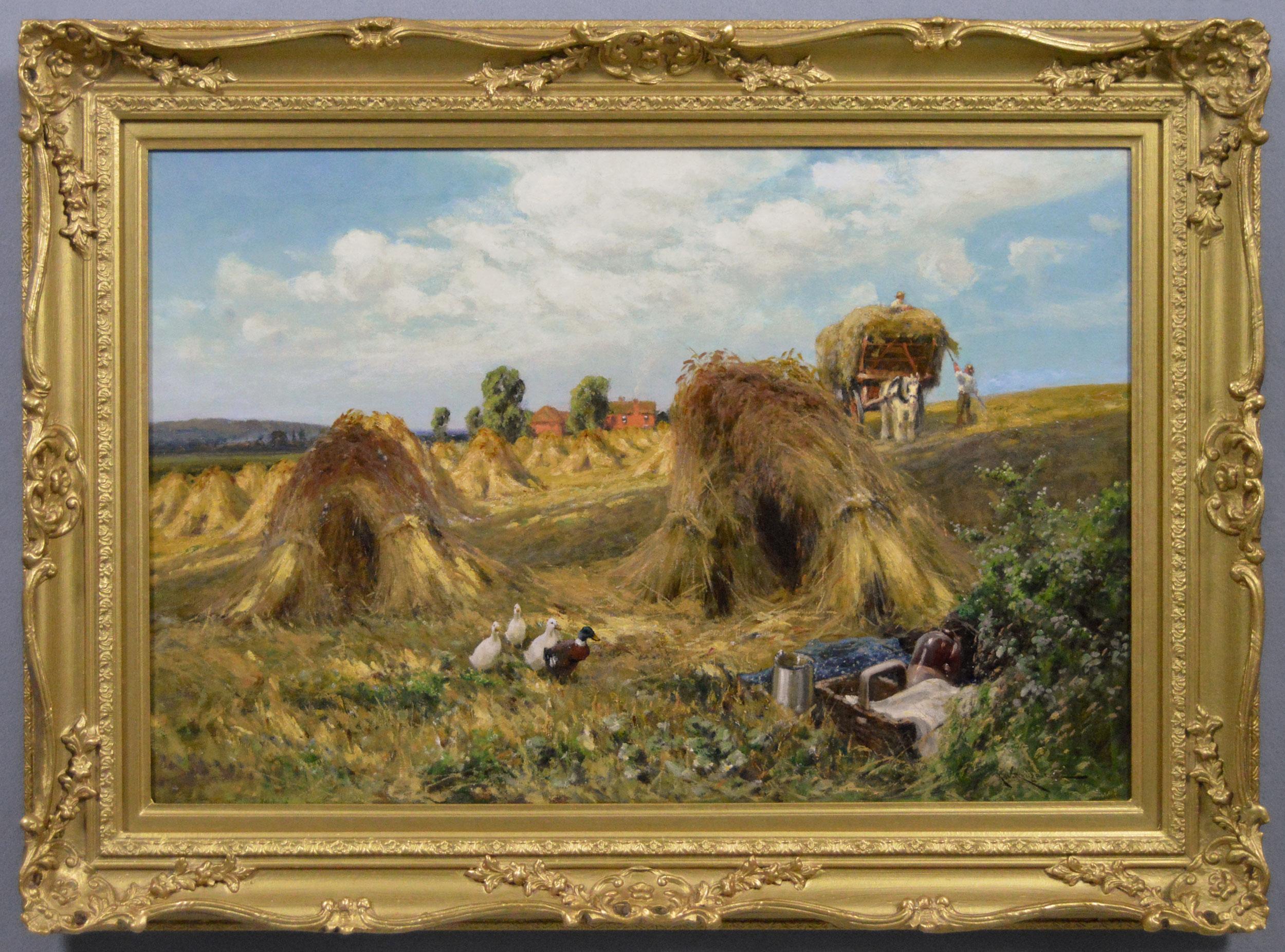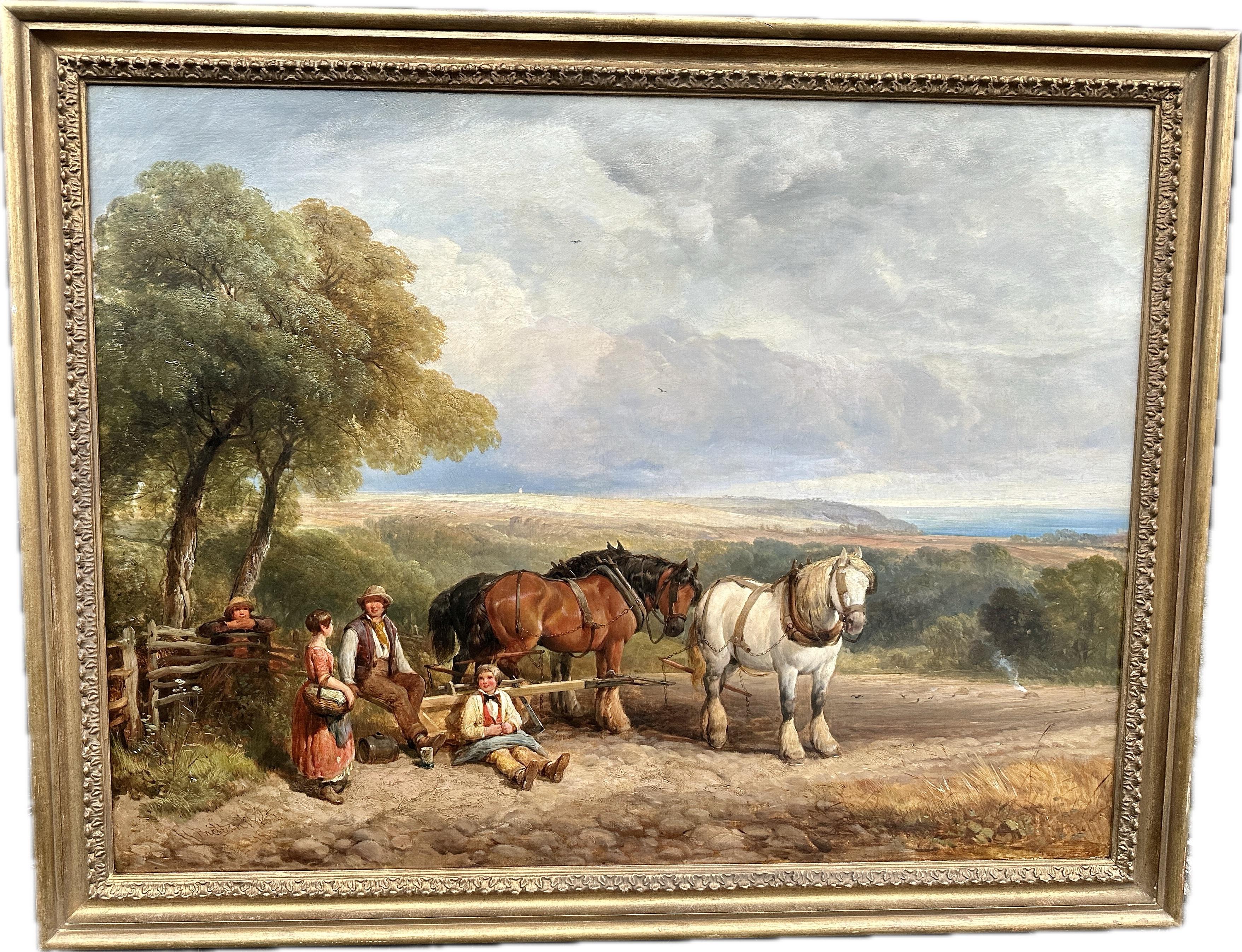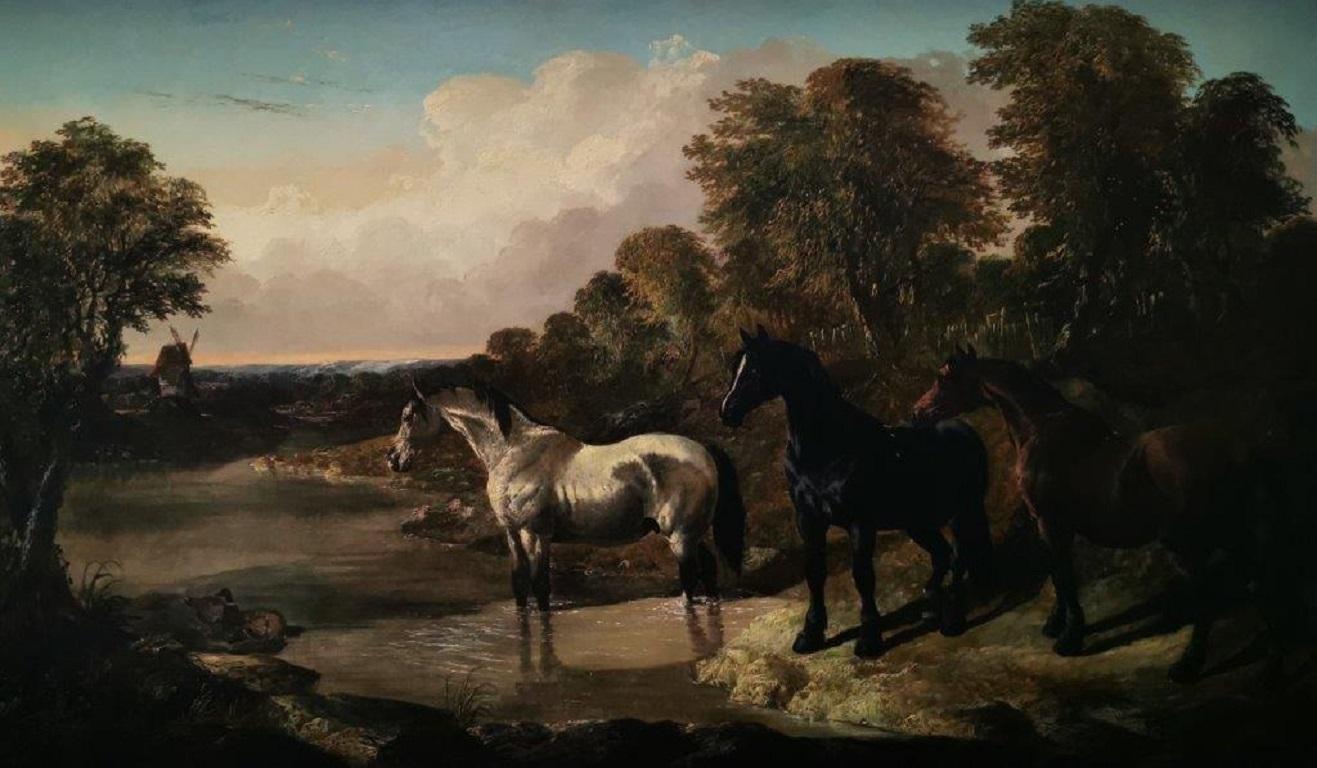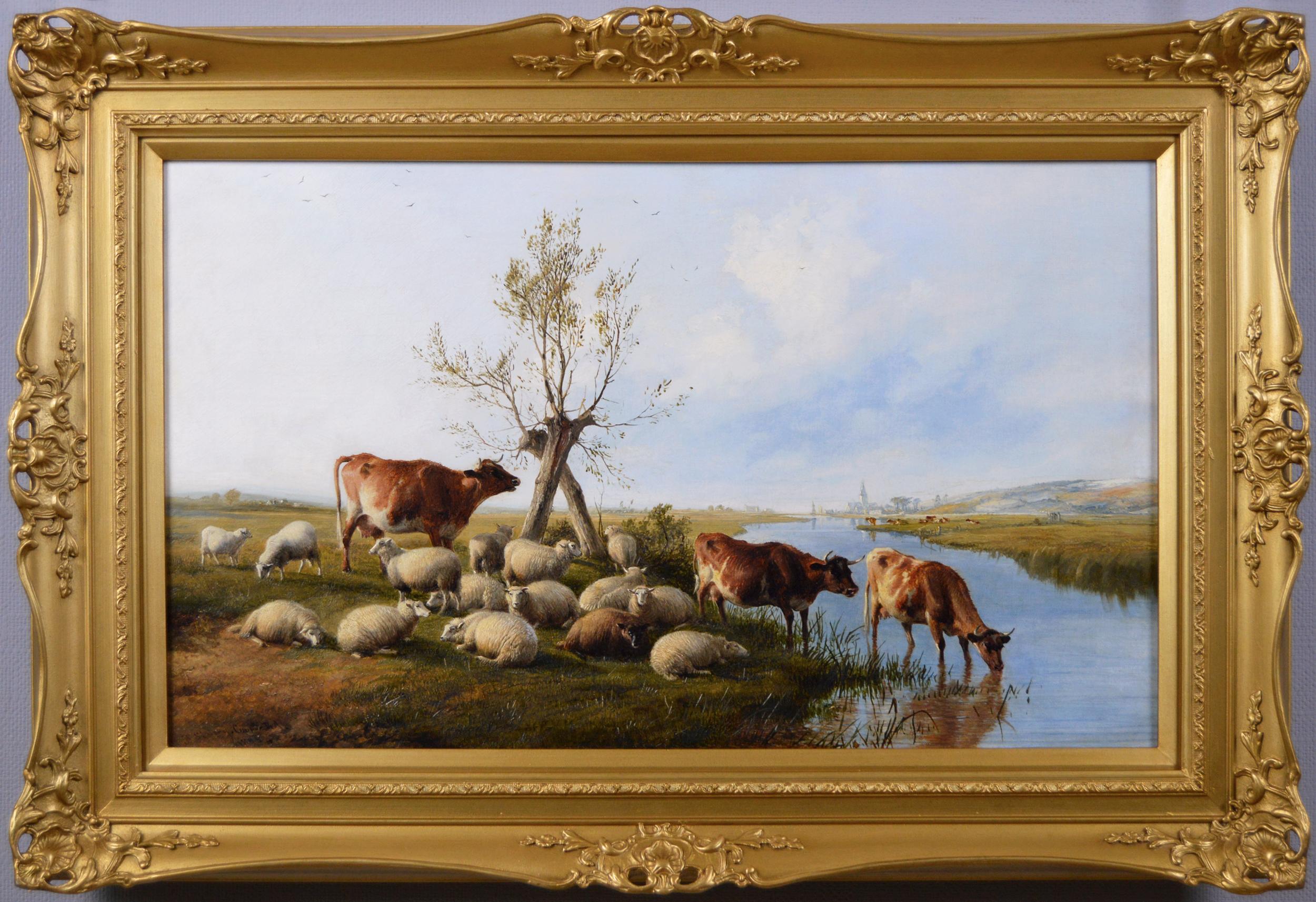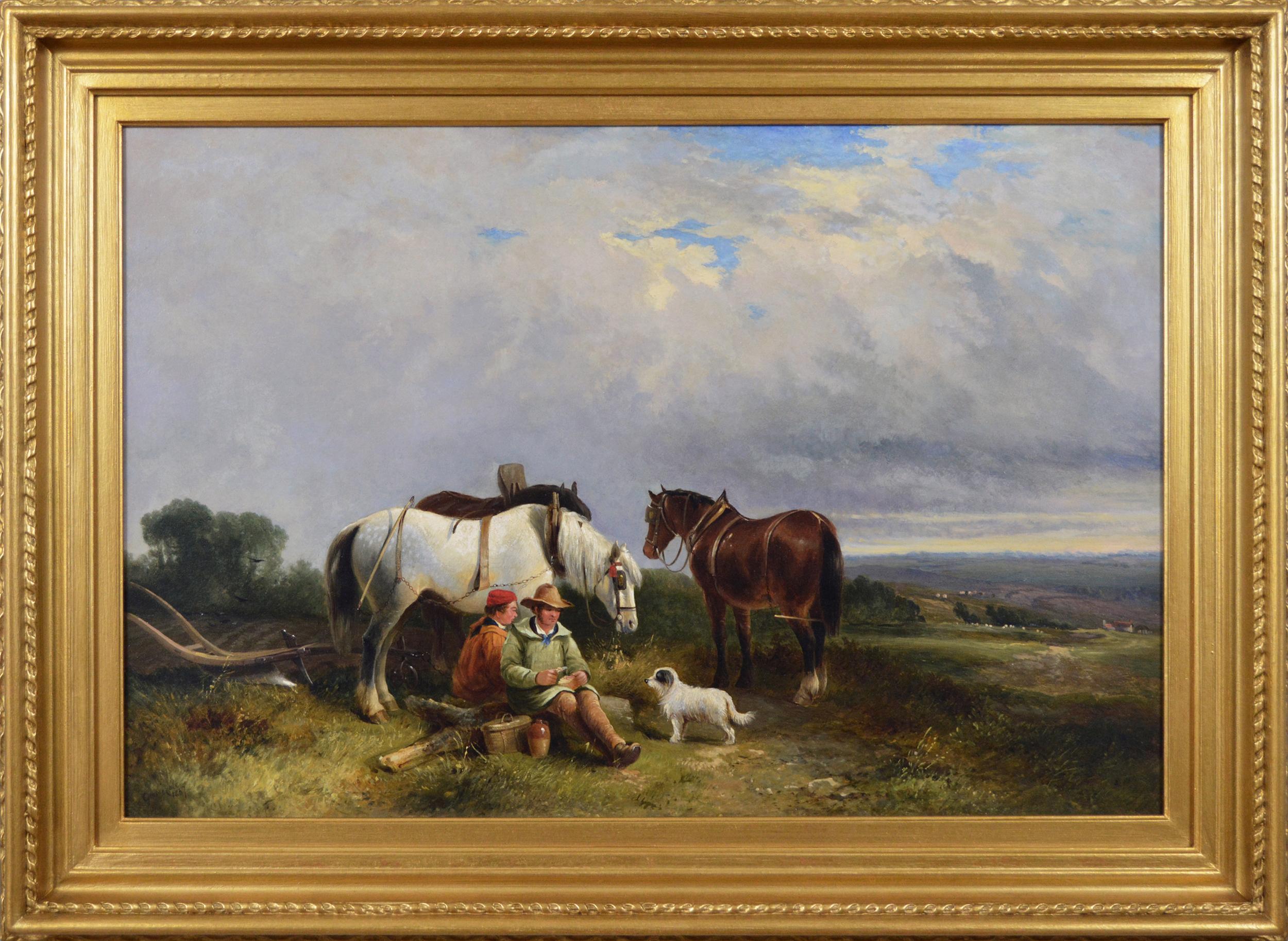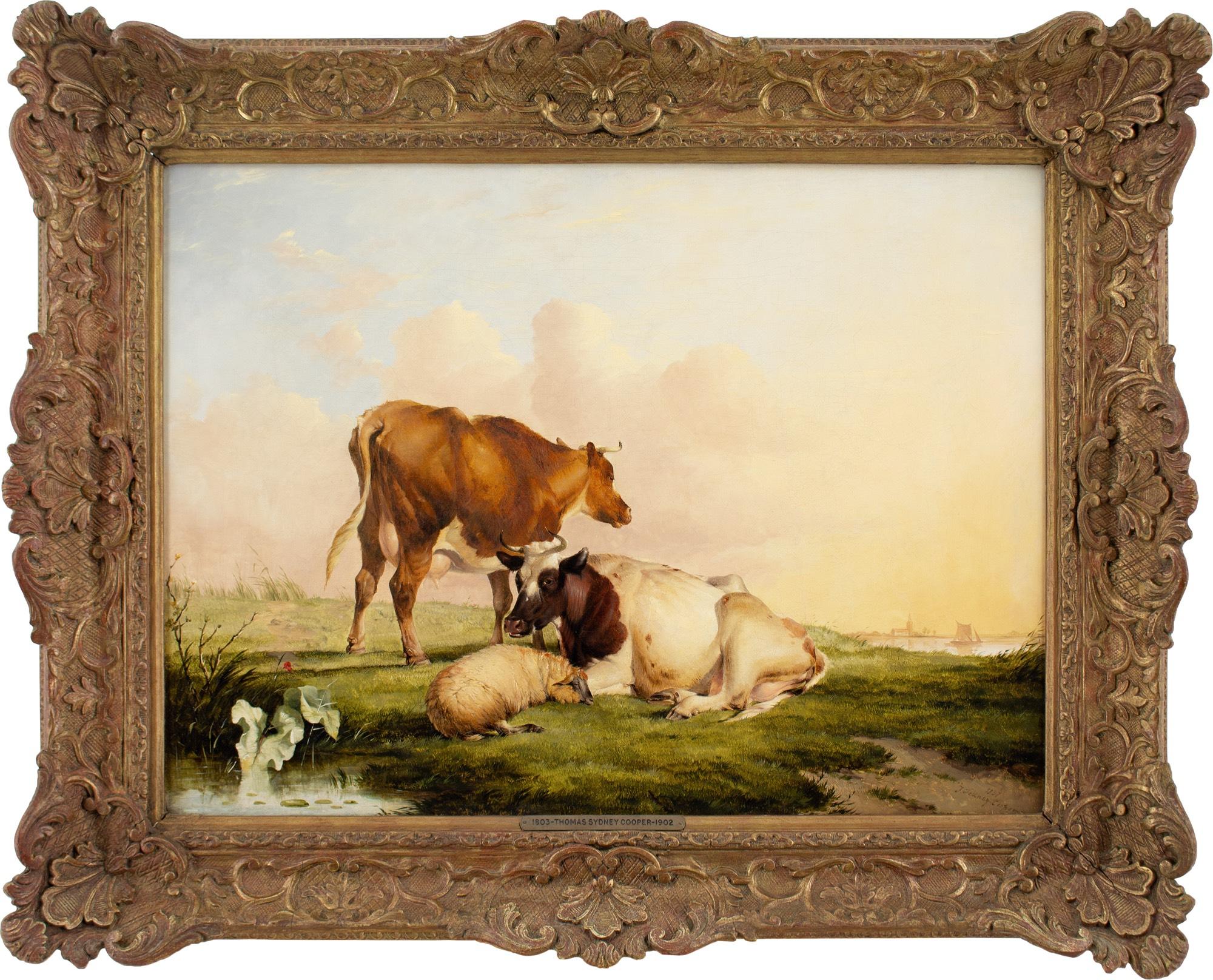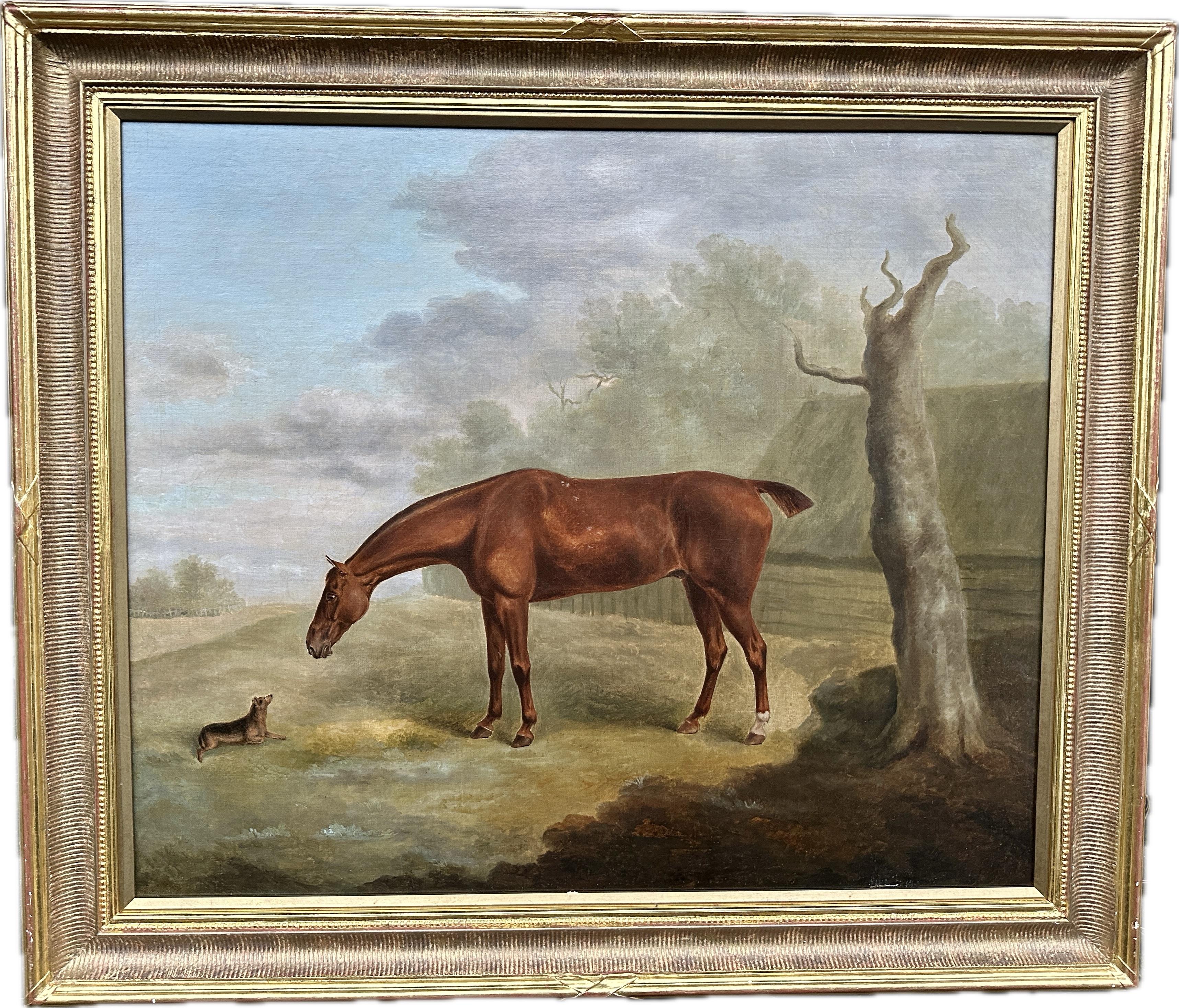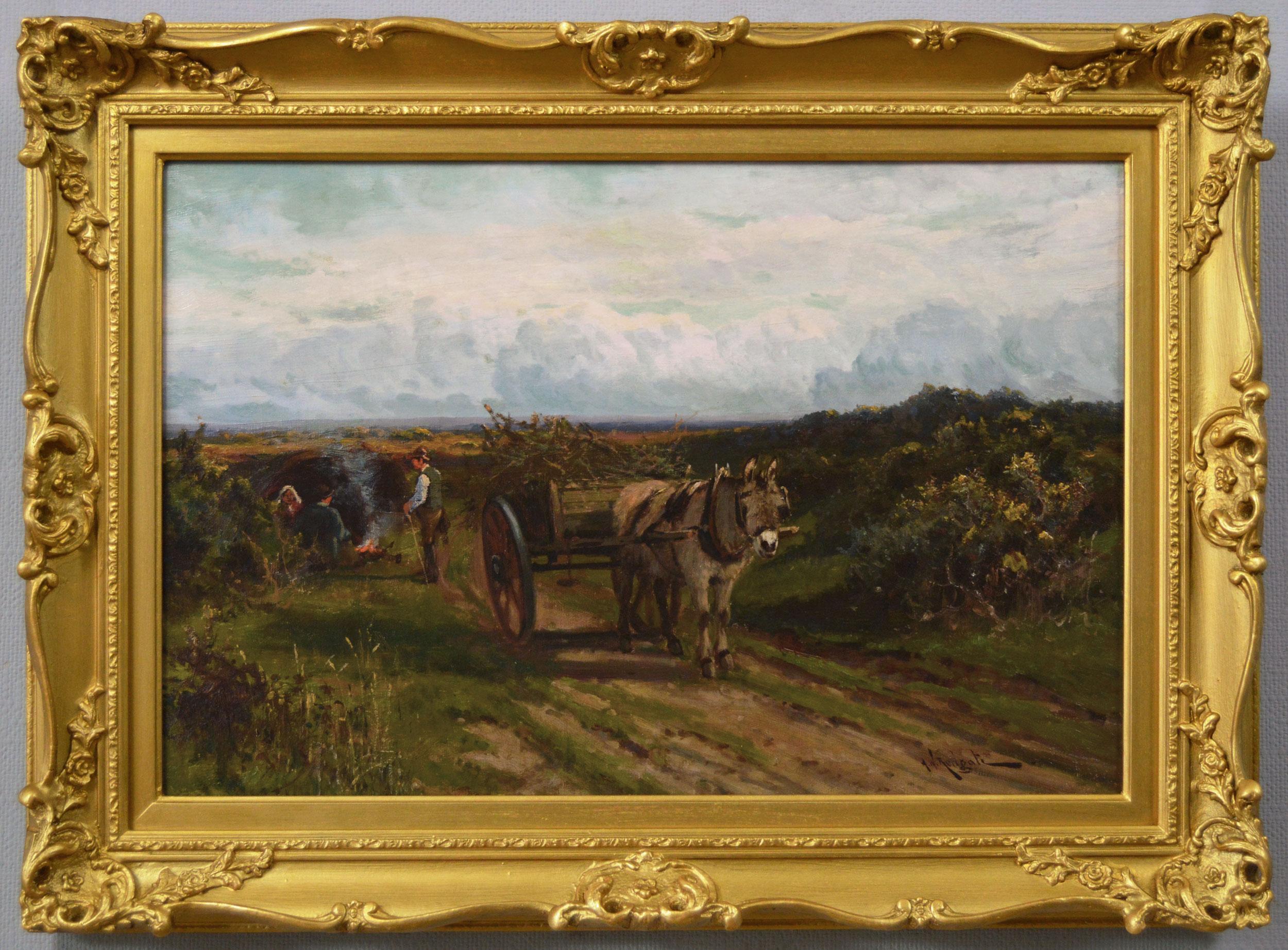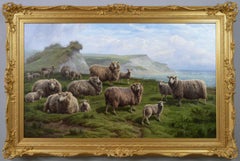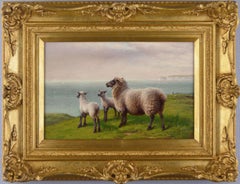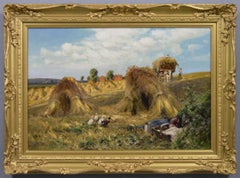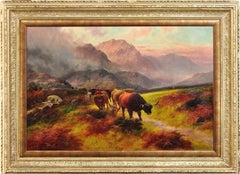
Glen Menteith, Scotland – Highland Cattle. Scottish Cows. Victorian Oil Painting
Want more images or videos?
Request additional images or videos from the seller
1 of 23
Henry Robinson HallGlen Menteith, Scotland – Highland Cattle. Scottish Cows. Victorian Oil Painting
About the Item
- Creator:Henry Robinson Hall
- Dimensions:Height: 33.47 in (85 cm)Width: 45.67 in (116 cm)Depth: 2.76 in (7 cm)
- Medium:
- Movement & Style:
- Period:
- Condition:This antique painting is in good condition, commensurate with its age. It is supplied ready to hang and display.
- Gallery Location:Sutton Poyntz, GB
- Reference Number:1stDibs: LU489314149982
About the Seller
5.0
Gold Seller
Premium sellers maintaining a 4.3+ rating and 24-hour response times
Established in 2010
1stDibs seller since 2016
120 sales on 1stDibs
Typical response time: 1 hour
Authenticity Guarantee
In the unlikely event there’s an issue with an item’s authenticity, contact us within 1 year for a full refund. DetailsMoney-Back Guarantee
If your item is not as described, is damaged in transit, or does not arrive, contact us within 7 days for a full refund. Details24-Hour Cancellation
You have a 24-hour grace period in which to reconsider your purchase, with no questions asked.Vetted Professional Sellers
Our world-class sellers must adhere to strict standards for service and quality, maintaining the integrity of our listings.Price-Match Guarantee
If you find that a seller listed the same item for a lower price elsewhere, we’ll match it.Trusted Global Delivery
Our best-in-class carrier network provides specialized shipping options worldwide, including custom delivery.More From This Seller
View AllDartmoor Ponies Early Morning Mist & Haze Devon Landscape 1930s Oil Painting
By Charles Walter Simpson
Located in Sutton Poyntz, Dorset
Charles Walter Simpson.
English ( b.1885 - d.1971 ).
Dartmoor Ponies, Devon.
Oil On Board.
Signed Lower Right.
Image size 20.7 inches x 28.2 inches ( 52.5cm x 71.5cm ).
Frame size 29.5 inches x 37 inches (75cm x 94cm ).
Available for sale; this original oil painting is by Charles Simpson and dates from the 1930s.
The painting is presented and supplied in a contemporary and sympathetic wood frame (which is shown in these photographs) mounted using conservation materials and behind non-reflective Artglass AR 70™ glass. The previous ply backboard has been retained and is secured onto the new replacement backboard for posterity.
This vintage painting is in very good condition, commensurate with its age. It wants for nothing and is supplied ready to hang and display.
The painting is signed lower right.
Previously with Harris & Sons, 70 George Street, Plymouth, Devon in July 1936.
Charles Walter Simpson, known as Walter, was a leading figure in the Newlyn and St Ives art colonies in the early part of the twentieth century. He is perhaps best known in America for his horse paintings but is also widely acclaimed for his mastery of birds. It has been said that as a painter of wildfowl Simpson can have few rivals. He worked in oils, watercolors and tempera.
Walter was born at Camberley on 8th May 1855. His mother was Leonora (nee Devas) and his father was Major-General Charles Rudyard Simpson of the Lincolnshire Regiment. Initially Walter was educated by a private tutor, and he later attended the Herkomer School at Bushey.
As a youngster Walter was destined for a military career. However, this was prevented by a riding accident which affected both his hearing and sight. He had a considerable talent for drawing and determined to become an artist instead. Walter was initially largely self-taught, but then received guidance from family friends such as G.F. Watts and H.W.B. Davis, RA. He later studied for a short time under the renowned animal artist Lucy Kemp-Welch at Bishley, then with Sir Alfred Munnings, with whom he developed a life-long friendship, at Swainsthorpe. Munnings encouraged him to visit Cornwall, where he studied under Stanhope Forbes RA in Newlyn. Simpson’s first home in West Cornwall was Penzer House in Newlyn, where he was living in 1908. Finally, Simpson completed his studies at the Academie Julien in Paris in 1910.
On his return from Paris, Simpson moved to Cornwall again and became engaged to fellow artist Ruth Alison just a couple of days after first meeting her. They were married in 1913, living first in Newlyn and then in Lamorna at “Brodriggy”. They had a daughter, Leonora, born in 1914. In 1916 Simpson and his family moved to St. Ives to set up their own School of Painting, which they ran from numbers 1 and 2 Piazza Studios. During this period Simpson dominated the St. Ives art scene. The family moved back to London in 1924 but returned to Cornwall in 1931. Altogether, they moved between West Cornwall and London eleven times.
From his studio in Cornwall Simpson painted in earnest, often on a grand scale, producing wonderful large decorative canvases, specialising in wild ducks, gulls and other sea birds. He had a reputation as an outstanding animal and bird painter. Paget described Charles Simpson in 1945 as “undoubtedly the best bird painter living. He alone, of all artists past and present, can make his birds appear out of their backgrounds as one approaches them, or the light is increased as in nature…”. Simpson relished painting en plein air and Laura Knight commented, "He was so prodigal with paint, he could be traced by the color left on the bushes!".
Simpson first exhibited at the Royal Academy in 1906, initially painting mainly non-sporting subjects. From then on, he was a regular contributor to the Royal Academy exhibitions. It was not until 1924, when a rodeo was held at Wembley during which he worked in the ring and produced a book call El Rodeo...
Category
1930s Impressionist Animal Paintings
Materials
Oil
Highland Cattle Scottish Loch Landscape Scotland Circa 1890 Framed Oil Painting
Located in Sutton Poyntz, Dorset
Henry Robinson Hall.
English ( b.1857 - d.1927 ).
Highland Cattle In The Margins Of A Scottish Loch.
Oil On Canvas.
Signed Lower Left.
Image size 23.4 inches x 15.4 inches ( 59.5cm x...
Category
Late 19th Century Victorian Animal Paintings
Materials
Canvas, Oil
Highland Cattle In A Scottish Upland Landscape Scotland Framed Oil Painting
Located in Sutton Poyntz, Dorset
Henry Robinson Hall.
English ( b.1857 - d.1927 ).
Highland Cattle In A Scottish Upland Pasture, 1891.
Oil On Canvas.
Signed & Dated Lower Left.
Image size 23.4 inches x 15.4 inches (...
Category
Late 19th Century Victorian Animal Paintings
Materials
Canvas, Oil
Pan God Of Nature Playing Panpipes Mythological Nude With Animals Oil Painting
By Margaret Maitland Howard
Located in Sutton Poyntz, Dorset
Margaret Maitland Howard.
English ( b.1898 - d.1983 ).
Pan, God Of Nature, Playing Panpipes.
Oil On Canvas.
Signed Lower Left.
Image size 22.6 inches x 18.1 inches ( 57.5cm x 46cm ).
Frame size 26.8 inches x 22.2 inches ( 68cm x 56.5cm ).
Available for sale; this original oil painting is by the English artist Margaret Maitland Howard and dates from the 1930s.
The painting is presented and supplied in a sympathetic contemporary frame (which is shown in these photographs), mounted with new fixtures.
The canvas has been lined and mounted on a newly constructed custom made stretcher. The painted surface has benefitted from cleaning and conservation, all of which was performed on our instruction, supervision and approval.
This vintage painting is now in very good condition. It wants for nothing and is supplied ready to hang and display.
The painting is signed lower left.
Margaret Maitland Howard was an accomplished and versatile English artist whose works spanned the early to mid-20th century. Known for her evocative and often mythologically inspired oil paintings, Howard’s work reflects a deep engagement with classical themes and her knowledge of nature, and the human form. She was also proficient working in watercolours and pastels and an accomplished sculptor.
Margaret, who was always known as “Marjorie” was born in Friern, Barnet, London on 31 July 1898, the daughter of artist and civil servant Henry James Howard. She grew up at Sutton, Surrey, where she spent most of her life. She spent many years living and working from St. Katherine’s, Malgrave Road, Sutton, Surrey.
She was educated privately, at the Byam Shaw and then attended the Vicat Cole School of Art, completing her studies at the Royal Academy Schools, where she won five silver medals and other awards. She was also the recipient of a British Institute scholarship and extension and won the 1926 prize for her portrait work at the National Welsh Eisteddfod in Swansea.
She exhibited paintings at the Royal Academy, showing at least ten works of classical and biblical themes at Summer Exhibitions between 1923 and 1935. She was one of the early group of women who painted nudes, a practice which was considered somewhat risqué and vulgar in the early twentieth century. She also exhibited at other leading galleries and in the provinces and consistently pursued her art despite the challenges posed by the societal norms of the time.
Howard had a significant professional career for a woman of her generation. Just after World War II she was appointed draughtsman to the Institute of Archaeology at London University where she worked from 1948 to 1960. This is now part of University College, London. Here, she worked as an illustrator and sculptor, creating models for Professor Frederick Zeuner to use in his lectures. She also illustrated one of his important books (Zeuner, F.E. Dating the Past, London: Methuen). She also created the bust of Gordon Childe, now in the Institute’s Library. After her retirement from the Institute of Archaeology she collaborated with Ian Wolfran Cornwall on his series of books about the prehistoric world.
In 1956, whilst working for the British Institute for the Study of Iraq, she moved to Balawat and supervised the archaeological work at the site of an ancient Assyrian city in northern Mesopotamia. She subsequently prepared drawings of the Balawat Gates, which was significant and technical work.
In addition to illustrating various books on ancient history and anthropology, Howard was also known as an illustrator of fictional books, producing an illustrated edition of the Fables of Aesop that was published by John Lane at The Bodley Head in 1926. She also illustrated Elizabeth Ward...
Category
Mid-20th Century Romantic Animal Paintings
Materials
Canvas, Oil
Milly With Minstrel Children And Their Childhood Pony In Dappled Summer Sunlight
Located in Sutton Poyntz, Dorset
Harold Walton Freckleton.
English ( b.1890 - d.1979 ).
Milly With Minstrel.
Oil On Canvas.
Signed Lower Right.
Image size 24.4 inches x 29.52 inches ( 62cm x 75cm ).
Frame size 30.7 inches x 35.8 inches ( 78cm x 91cm ).
Available for sale; this original oil painting is by the Nottingham artist Harry Freckleton and dates from the 1960s.
The painting is presented and supplied in its’ original wooden frame (which is shown in these photographs).
The frame, canvas and the painted surface have benefitted from cleaning, restoration and conservation, which was performed on our instruction, supervision and approval. The original cotton covered slip has been replaced.
This vintage painting is now in very good condition, defying its age. It wants for nothing and is supplied ready to hang and display.
The painting is signed lower right.
The acclaimed artist Harry Freckleton was born in Nottingham in 1890 and lived there for most of his life. He studied at the Nottingham School of Arts, as it was then known, from 1904 to 1912 under Wilson Foster and was much influenced by the local painter Arthur Spooner. He worked as a lithograph artist, and then served in the army during World War 1. He then worked as an artist for New Zealand Cine Studios and went on to run his own photographic business from 1924-65.
Freckleton married the artist Vera Freckleton and they spent most of their married life living in at Whitegates in The Park, Nottingham.
Most of Freckleton’s art is painted in oils, and he specialised in still life, landscape and figurative work, especially childhood scenes. His best works have a strong human interest, with an individual technique showing quality and fine execution. He was a member of the Nottingham Society of Artists, exhibiting there and becoming an esteemed Associate. As a successful artist Freckleton exhibited work seven times at the Royal Academy, as well as the Royal Society of Portrait Painters and the Royal Society of British Artists. His work continues to be sought-after and is today represented in permanent collections in Nottingham, Blackpool, Huddersfield and elsewhere.
© Big Sky Fine Art
This beautiful oil on canvas painting by Harry Freckleton shows a scene in an English farmyard. Besides an old green painted barn and a tall haystack, we see Minnie, a young girl sitting astride Minstrel, her brown pony. She is wearing a riding hat, white blouse and red trousers, and looks down at her left side towards a second figure, in a blue top and tan trousers, who is possibly adjusting her stirrups. A third figure, another girl, in grey blouse...
Category
Mid-20th Century Post-Impressionist Animal Paintings
Materials
Canvas, Oil
Working Horses At The Trough 1908 Chevaux À L'Abreuvoir French Rural Normandy
Located in Sutton Poyntz, Dorset
Raimond Louis Lecourt
French ( b.1882 - d.1946 ).
Chevaux À L'Abreuvoir, 1908. (Horses At The Trough).
Oil On Canvas.
Signed & Dated 1908 Lower Left.
Image size 14.2 inches x 17.3 in...
Category
Early 20th Century French School Animal Paintings
Materials
Canvas, Oil
You May Also Like
19th Century exhibition size landscape oil painting of Sheep on a cliff
By Charles Jones (b.1836)
Located in Nr Broadway, Worcestershire
Charles Jones
British, (1836-1892)
Sheep Resting
Oil on canvas, signed with monogram & dated 1877, further inscribed verso
Image size: 35 inches x 59 inches
Size including frame: 47 inches x 71 inches
Exhibition Size Painting
A fantastic exhibition sized landscape painting of sheep on a cliff top by the coast by Charles ‘Sheep’ Jones. At the time he produced this painting, Jones was living at Heathercroft, Balham Hill in London. Given the size and quality of the work it was most likely an exhibition piece. The topography and landscape suggest that this is the Dorset coast, one of his favourite places to paint.
Charles Jones was an animal painter who was born in Stepney, London in 1836. He was the son of the artist Samuel John Egbert Jones (1797-1861) and Dinah Jones. He lived with his parents and 9 siblings in Mile End and was a pupil of his father. In September 1859, he married Frances Rosalinda Downe, who was born in America. His son Arthur Bertram Loud (1863-1930) also became an artist. They lived at 12 Hayes Place, Lisson Grove from where he made his debut in London at the Royal Academy in 1861. He also exhibited at the British Institution, Suffolk Street, New Watercolour Society, Royal Institute of Oil Painters and the Royal Institute of Painters in Watercolours.
By 1867, he had become a successful artist and they had moved to 7 Paragon Place, Brixton Hill. From 1874 he lived at Heathercroft, Balham Hill where he spent the rest of his life. Jones became well known for specialising in paintings of sheep, cattle and deer in landscape settings. He spent his time travelling around visiting areas such as Devon, Dorset, Kent, Sussex and the Highlands. However, it is for his skilful painting of sheep that he is perhaps best known, and for which earned him the nickname of ‘Sheep’ Jones.
As well as the major London galleries, he also exhibited provincially at various locations including: the Royal Cambrian Academy where he was elected a member in 1886, the Glasgow Institute of Fine Arts, Manchester City Art Gallery, Royal Hibernian Academy, Royal Society of British Artists, Birmingham and the Walker Art Gallery, Liverpool. Some of the smaller more intimate galleries he exhibited at were Arthur Tooth & Sons and Thomas...
Category
19th Century Victorian Animal Paintings
Materials
Canvas, Oil
19th Century Welsh river landscape oil painting near Betws-y-Coed
By Alfred de Breanski Sr.
Located in Nr Broadway, Worcestershire
Alfred de Breanski Snr
British, (1852-1928)
Near the Fairy Glen Betws-y-Coed
Oil on canvas, signed & transcribed verso
Image size: 23.5 inches x 35.5 inches
Size including frame: 31 ...
Category
19th Century Victorian Landscape Paintings
Materials
Canvas, Oil
19th Century landscape oil painting of sheep grazing on a clifftop
By Charles Jones (b.1836)
Located in Nr Broadway, Worcestershire
Charles Jones
British, (1836-1892)
Sheep Grazing on a Cliff Top
Oil on canvas, signed with monogram
Image size: 7.5 inches x 11.5 inches
Size including frame: 13.5 inches x 17.5 inches
Charles Jones was an animal painter who was born in Stepney, London in 1836. He was the son of the artist Samuel John Egbert Jones (1797-1861) and Dinah Jones. He lived with his parents and 9 siblings in Mile End and was a pupil of his father. In September 1859, he married Frances Rosalinda Downe, who was born in America. His son Arthur Bertram Loud (1863-1930) also became an artist. They lived at 12 Hayes Place, Lisson Grove from where he made his debut in London at the Royal Academy in 1861. He also exhibited at the British Institution, Suffolk Street, New Watercolour Society, Royal Institute of Oil Painters and the Royal Institute of Painters in Watercolours.
By 1867, he had become a successful artist and had moved to 7 Paragon Place, Brixton Hill. From 1874, he lived at Heathercroft, Balham Hill where he spent the rest of his life. As well as the major London galleries, he also exhibited provincially at various locations including: the Royal Cambrian Academy where he was elected a member in 1886, the Glasgow Institute of Fine Arts, Manchester City Art Gallery, Royal Hibernian Academy, Royal Society of British Artists, Birmingham and the Walker Art Gallery, Liverpool. Some of the smaller more intimate galleries he exhibited at were Arthur Tooth & Sons and Thomas Richardson...
Category
19th Century Victorian Animal Paintings
Materials
Canvas, Oil
19th Century landscape oil painting of ducks in a harvest field
Located in Nr Broadway, Worcestershire
Arthur Walker Redgate
British, (1860-1906)
Lunchtime
Oil on canvas, signed
Image size: 19.5 inches x 29.5 inches
Size including frame: 27.25 inches x 37.25 inches
A charming harves...
Category
19th Century Victorian Landscape Paintings
Materials
Canvas, Oil
19th century English Harvest landscape with horses, farmers, children, family
Located in Woodbury, CT
Henry Brittian Willis
English plough team at rest during harvest Summertime.
A painting by Henry Brittiam Willis capturing a 19th-century English plough team, complete with horses,...
Category
1850s Victorian Landscape Paintings
Materials
Canvas, Oil
"A River Landscape with Wild Horses", Victorian original, oil on canvas
By John Frederick Herring Jr
Located in Naples, Florida
This is an original unique oil painting by the artist. Born into an artistic family in Doncaster, England during 1820. Best known for his equine art, of the same character as those of the elder Herring, including "The Home Farm," "The Homestead," "The Farm-Yard," etc.John F. Herring, Jr. was born in Doncaster, South Yorkshire c.1820, to the well-known 19th-century artist John Frederick Herring, Sr. (1795-1865), who at the time, was considered one of England's great Sporting and Equestrian artists, patronized by the English aristocracy. The father's mastery of the brush, and popularity with the nobility, served his son, Herring, Jr., well. Early on, John, Jr. was exposed to fine painting and wealthy patrons. Recent reference books state that Herring, Sr.'s first child was named "John Frederick Herring, Jr." and was born on June 21, 1815. John Herring, Jr. developed a love for painting, a passion also shared by his brothers Charles and Benjamin. Three of the
four brothers became artists, painting in the same style as their father, often collaborating on a single painting. In the years after 1836, Herring, Sr., feeling threatened by the teenage John Herring, Jr.'s ability and growing popularity, began incorporating the tag "SR" at the end of his signature. John Herring, Jr. continued painting in the tradition of his father, the sporting and animal pictures...
Category
19th Century Victorian Landscape Paintings
Materials
Canvas, Oil
